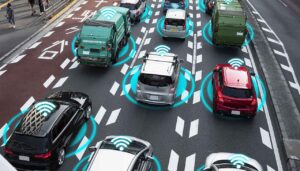
Girl drive a car and look from window on traffic jam
In an era where technological innovation is paramount, the automotive industry stands at the forefront of integrating advanced safety features to protect passengers and pedestrians alike. These groundbreaking technologies not only aim to mitigate the impact of accidents but also work proactively to prevent them, marking a significant step towards safer roads worldwide. This document endeavors to examine the latest advances in automotive safety technologies, highlighting how they are setting new standards in vehicle safety and transforming the driving experience into one that prioritizes human life and well-being above all.
Autonomous Emergency Braking (AEB)
Autonomous Emergency Braking (AEB) is a revolutionary safety feature that utilises sensors and radar technology to detect potential collisions before they occur. When a potential collision is detected, the AEB system initially alerts the driver through visual and auditory warnings. If the driver fails to respond, the system automatically applies the brakes to either prevent the crash entirely or significantly reduce the impact force. This preemptive action plays a critical role in enhancing road safety by giving vehicles the ability to react quicker than a human could.
The benefits of AEB are substantial in preventing collisions. It addresses the human error element, which is a leading cause of road accidents, by providing an additional layer of safety. Studies have shown that AEB can reduce rear-end collisions by up to 27%, substantially lowering the risk of injuries and fatalities on the road.
Statistics and case studies underscore the effectiveness of AEB. According to a report by the Insurance Institute for Highway Safety (IIHS), vehicles equipped with AEB saw a 50% decrease in front-to-rear crash rates compared with vehicles without it. Another study from the European Road Safety Observatory indicated that AEB technology could potentially save thousands of lives annually as its adoption becomes more widespread. These findings highlight the pivotal role of AEB in paving the way for safer driving conditions and reaffirm the automotive industry’s commitment to leveraging technology for enhancing road safety.
Adaptive Cruise Control (ACC)
Adaptive Cruise Control (ACC) represents a significant leap forward in automotive safety and comfort. This intelligent feature automatically adjusts a vehicle’s speed to maintain a safe distance from the car ahead, leveraging sensor and radar technologies. Unlike traditional cruise control that maintains a constant speed, ACC dynamically adapts based on traffic flow, seamlessly accelerating or decelerating as needed.
The advantages of ACC extend beyond maintaining safe following distances. It plays a crucial role in reducing driver fatigue on long journeys by managing speed and spacing without constant input from the driver. This automation not only enhances comfort but also significantly decreases the likelihood of collisions caused by human error or inattention, especially in congested traffic scenarios.
Real-world implementations of ACC underscore its potential to improve road safety. Several automotive manufacturers have reported reductions in rear-end collisions as a direct result of ACC systems. For instance, a study conducted by Volvo demonstrated a 45% decrease in rear-end collisions in vehicles equipped with ACC and other integrated safety technologies. Similarly, Mercedes-Benz found that the introduction of ACC contributed to a notable reduction in accidents involving their vehicles on highways. These examples highlight the impact of ACC in fostering safer driving environments, illustrating the technology’s pivotal role in the evolution of automotive safety.
Blind Spot Detection
Blind Spot Detection
Blind Spot Detection (BSD) systems serve as a critical technology in the quest to enhance vehicle safety, significantly reducing the risk of accidents caused by the driver’s inability to see other vehicles in the so-called “blind spots.” These areas, which are not visible through the rearview or side mirrors, pose a significant hazard, particularly when changing lanes or merging into traffic. BSD technologies employ sensors or cameras to monitor these areas, alerting the driver with visual, auditory, or haptic signals when another vehicle is detected in the blind spot.
The importance of detecting vehicles in blind spots cannot be overstated, as failing to notice a vehicle while attempting a lane change is a common cause of collisions. By providing real-time alerts, BSD systems give drivers the crucial information needed to make safer decisions, thereby preventing potential accidents. This technology is especially beneficial on highways and in dense traffic conditions, where the pace and complexity of surrounding vehicular movements demand constant vigilance.
Comparative analysis reveals that blind spot detection technologies vary widely across automotive manufacturers, with differences primarily in the method of detection (such as radar, ultrasonic sensors, or cameras) and the way in which alerts are communicated to the driver. Some systems solely offer visual warnings via indicators on the side mirrors, while more advanced systems may incorporate auditory alarms or vibration warnings in the steering wheel or seat, drawing the driver’s attention more effectively to the potential hazard. Additionally, certain high-end models integrate BSD with other safety systems, such as lane-keeping assist and rear cross-traffic alert, to provide a more comprehensive safety net for the driver.
In sum, Blind Spot Detection technology is a vital component in the contemporary automotive safety ecosystem, offering substantial benefits in accident prevention and driver awareness. Its integration into new vehicle models underscores the automotive industry’s commitment to utilizing technological innovations to protect occupants and reduce road fatalities.
Lane Departure Warning (LDW) and Lane Keeping Assist (LKA)
Lane Departure Warning (LDW) and Lane Keeping Assist (LKA) systems exemplify the advancement of vehicle safety technologies aimed at preventing lane departure accidents. LDW alerts the driver when the vehicle begins to drift out of its lane without signaling, employing visual, auditory, or haptic feedback to prompt corrective action. Meanwhile, LKA takes a more proactive approach by automatically steering the vehicle back into its lane if the driver fails to respond to the initial warning. Together, these technologies play a vital role in mitigating one of the common causes of road accidents — unintended lane departures.
These innovations have demonstrated significant potential in preventing accidents resulting from driver inattention, fatigue, or distraction. By alerting drivers to unintentional lane deviations and, when necessary, actively intervening to maintain lane integrity, LDW and LKA systems greatly reduce the likelihood of collisions with adjacent vehicles or off-road incidents.
Consumer adoption of LDW and LKA technologies has been steadily increasing, propelled by growing awareness of their benefits for road safety and the push towards autonomous driving capabilities. Feedback from users has been predominantly positive, with many drivers appreciating the added layer of safety and peace of mind these systems provide. However, some have expressed concerns about overreliance on the technology and the potential for false alerts in complex driving scenarios. Despite these challenges, the overall consensus underscores the importance of LDW and LKA in the evolution of automotive safety, highlighting their role in shaping a future with fewer road accidents.





